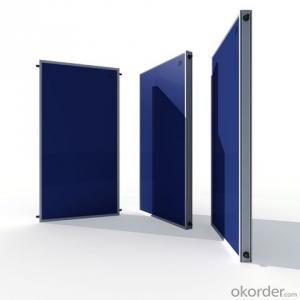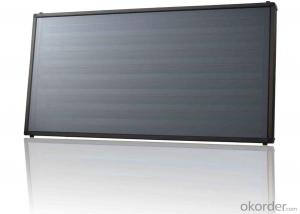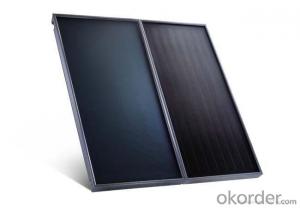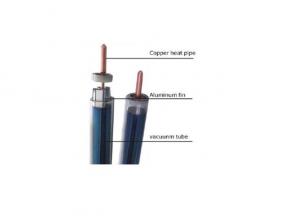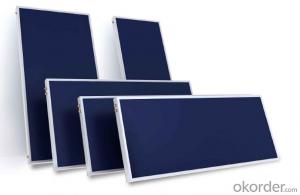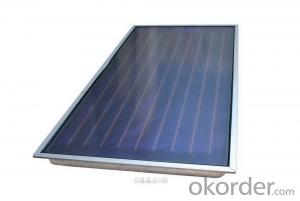HOT Solar EVACUATED TUBE WITH HEAT PIPE SOLAR THERMAL COLLECTOR,Model No:FP-GV2.05-01-A
- Loading Port:
- Shanghai
- Payment Terms:
- TT OR LC
- Min Order Qty:
- 500 pc
- Supply Capability:
- 10000 pc/month
OKorder Service Pledge
OKorder Financial Service
You Might Also Like
HOT Solar EVACUATED TUBE WITH HEAT PIPE SOLAR
THERMAL COLLECTOR
Model No:FP-GV2.05-01-A ( 2015*1015*76mm)
Solar Collector Characteristics:
♦Germany imported blue titanium selectve coating,the most efficient absorber in the world
♦ Whole plate laser welding,to minimize the damage to absorption layer and copper tube
♦ 25 years lifespan
♦ Advanced processing technology and equipment,to guarantee products in high quality
Quality Assurance--Solar Collector Test
Internal pressure for absorber
* High temperature resistance
* Exposure test
* External thermal shock
* Internal thermal shock
* Rain penetration
* Mechanical load test
* Thermal performance
* Freeze resistance test
* Ice ball impact test
In-process
-Laser welder between absorber and copper tubing
-Process test with digital pressure meter at 1.2Mpa 5 minutes
-Automatic S type bending machine
-Automatic frame cutter
-Automatic frame assembly machine
-Automatic copper drilling machine
-Automatic plate leveling machine
Specifications:
Dimension L×W × H(mm):2015*1015*76mm
Gross Area(m²):2.05 m²
Absorber Area (m²): 1.82 m²
Number of covers:1
Cover material:Low iron tempered glass
Cover Thickness(mm):3.2mm
Cover Transmittance:>92%
Weight:41.5 Kg
Absorber:
Material:Aluminium board
Surface Treatment:Sputtering(Germany imported Blue titanium coating)
Absorptivity:95±2%
Emissivity: 5±2%
Construction Type:Grid type
Header Material:Copper TP2/CA1220
Header tube Size:Ø22mm x (thickness) 0.8 mm
Riser tuber size: Ø8mm x (thickness) 0.75mm
Working pressure: 0.75MPa
Test pressure: 1.2MPa, keeps 30 minutes
Whole Collector:
Maximum power, G = 1,000W/m² per collector: 1.352 kW
Thermal efficiency: 0.788
Heat loss coefficient (a1): 3.411 W/m².K
Heat loss coefficient (a2): 0.024 W/m².K
Maximum stagnation temperature for ambient conditions of 1,000W/m² and 30°C: 188.4°C
Thermal Insulation:
Insulation material: fiberglass
Insulation thickness: 35 ± 5mm
Insulation Density: 48 kg/cube
- Q:Can solar collectors be used for heating churches?
- Yes, solar collectors can be used for heating churches. Solar thermal systems can harness the energy from the sun to generate heat, which can then be used to warm up the interior spaces of churches. By installing solar collectors on the roof or nearby areas, churches can significantly reduce their reliance on traditional heating methods and lower their energy costs while promoting sustainable practices.
- Q:How do evacuated tube solar collectors work?
- Evacuated tube solar collectors work by harnessing the power of the sun to generate heat. These systems consist of a series of glass tubes, each containing a copper heat pipe, which is surrounded by a vacuum. When sunlight hits the tubes, the heat is absorbed by the copper heat pipe, which then transfers the heat to a liquid or gas inside the pipe. This heated fluid is then used to heat water or air, which can be used for various purposes such as heating buildings or providing hot water. The vacuum surrounding the heat pipe helps to minimize heat loss, making evacuated tube solar collectors highly efficient even in colder climates.
- Q:Can solar collectors be used in the transportation sector?
- Solar collectors, also referred to as solar panels, have the potential to be utilized within the transportation industry. Vehicles can be equipped with solar collectors, enabling them to harness solar energy and convert it into usable electricity. This electricity can then be employed to either power electric vehicles or supplement the energy requirements of conventional vehicles. Various types of transportation, such as cars, buses, bicycles, and boats, have already seen the development and usage of solar-powered vehicles. These vehicles often incorporate solar panels into their design or install them on their roofs to capture sunlight and charge their batteries. Moreover, solar collectors can be employed to generate electricity for charging stations, providing a renewable energy source for electric vehicles. By incorporating solar energy into the transportation sector, we can diminish our dependence on fossil fuels, reduce greenhouse gas emissions, and contribute to a more sustainable and eco-friendly future.
- Q:Can solar collectors be used in natural gas power plants?
- Yes, solar collectors can be used in natural gas power plants. Solar collectors can be integrated into natural gas power plants to supplement the energy generated by burning natural gas. This hybrid approach can help reduce the reliance on fossil fuels and decrease greenhouse gas emissions.
- Q:Can solar collectors be used for heating livestock buildings?
- Yes, solar collectors can be used for heating livestock buildings. Solar collectors, such as solar water heaters or solar air heaters, can capture the sun's energy and convert it into heat. This heat can then be utilized to warm up the livestock buildings and create a more comfortable environment for the animals. Solar heating systems are a sustainable and cost-effective solution for heating livestock buildings, reducing reliance on traditional heating methods and minimizing energy costs.
- Q:Can solar collectors be used for heating car manufacturing plants?
- Yes, solar collectors can be used for heating car manufacturing plants. Solar thermal systems can provide heat for various industrial processes, including space heating, water heating, and even specific manufacturing processes. By harnessing solar energy, car manufacturing plants can reduce their reliance on fossil fuels and lower their carbon footprint.
- Q:How do solar collectors perform in areas with high pollution levels?
- Solar collectors may not perform optimally in areas with high pollution levels due to the reduced amount of sunlight reaching the panels. The presence of pollutants in the atmosphere can block or scatter sunlight, leading to decreased efficiency and energy generation of the solar collectors. Regular cleaning and maintenance of the panels may also be required to ensure their proper functioning in such areas.
- Q:Vacuum tube for solar collectors
- Good insulation: heat pipe has a one-way heat transfer characteristics, so that hot water at night will not heat down the heat pipe to the surrounding environment.
- Q:Can solar collectors be used for heating water in freezing temperatures?
- Yes, solar collectors can be used for heating water in freezing temperatures. While the efficiency of solar collectors may be reduced in extremely cold weather, they can still generate enough heat to warm water. Additionally, many solar water heating systems include features such as insulated pipes and heat exchangers that help prevent freezing and ensure the water remains hot. Moreover, antifreeze solutions are often used in the solar collectors to prevent freezing. Overall, solar collectors can still be an effective and reliable method for heating water even in freezing temperatures.
- Q:Can solar collectors be used in both residential and commercial applications?
- Yes, solar collectors can be used in both residential and commercial applications. They are versatile and can be installed on rooftops, facades, or ground-mounted systems in homes, businesses, and large commercial buildings alike.
1. Manufacturer Overview |
|
|---|---|
| Location | |
| Year Established | |
| Annual Output Value | |
| Main Markets | |
| Company Certifications | |
2. Manufacturer Certificates |
|
|---|---|
| a) Certification Name | |
| Range | |
| Reference | |
| Validity Period | |
3. Manufacturer Capability |
|
|---|---|
| a)Trade Capacity | |
| Nearest Port | |
| Export Percentage | |
| No.of Employees in Trade Department | |
| Language Spoken: | |
| b)Factory Information | |
| Factory Size: | |
| No. of Production Lines | |
| Contract Manufacturing | |
| Product Price Range | |
Send your message to us
HOT Solar EVACUATED TUBE WITH HEAT PIPE SOLAR THERMAL COLLECTOR,Model No:FP-GV2.05-01-A
- Loading Port:
- Shanghai
- Payment Terms:
- TT OR LC
- Min Order Qty:
- 500 pc
- Supply Capability:
- 10000 pc/month
OKorder Service Pledge
OKorder Financial Service
Similar products
New products
Hot products
Hot Searches









